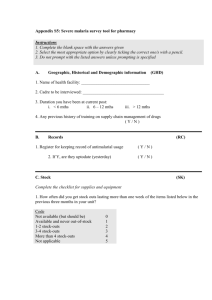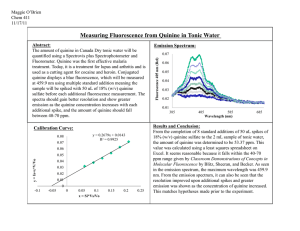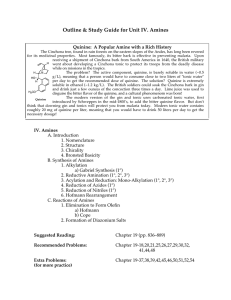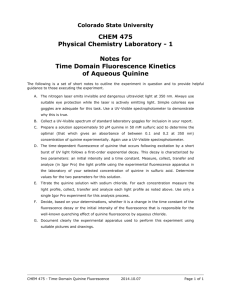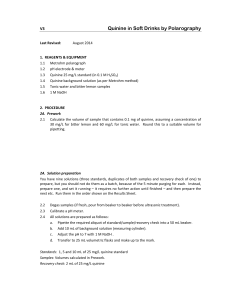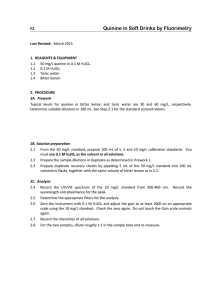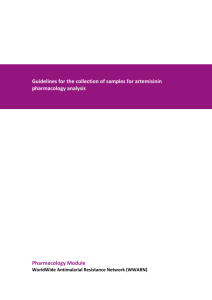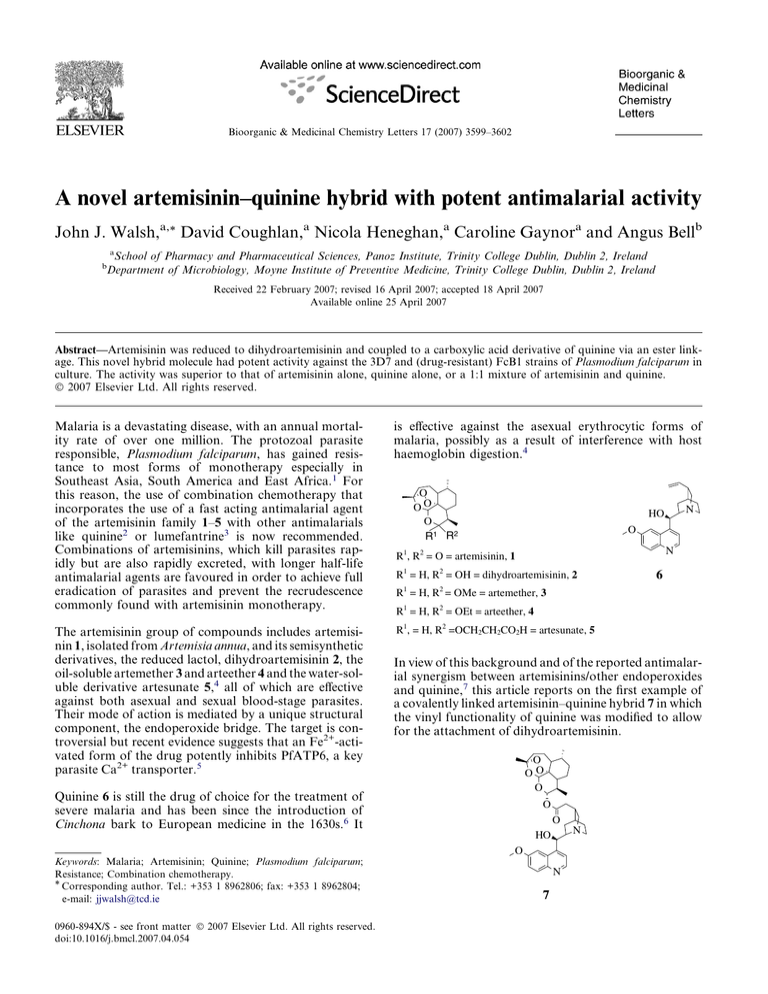
Bioorganic & Medicinal Chemistry Letters 17 (2007) 3599–3602
A novel artemisinin–quinine hybrid with potent antimalarial activity
John J. Walsh,a,* David Coughlan,a Nicola Heneghan,a Caroline Gaynora and Angus Bellb
a
b
School of Pharmacy and Pharmaceutical Sciences, Panoz Institute, Trinity College Dublin, Dublin 2, Ireland
Department of Microbiology, Moyne Institute of Preventive Medicine, Trinity College Dublin, Dublin 2, Ireland
Received 22 February 2007; revised 16 April 2007; accepted 18 April 2007
Available online 25 April 2007
Abstract—Artemisinin was reduced to dihydroartemisinin and coupled to a carboxylic acid derivative of quinine via an ester linkage. This novel hybrid molecule had potent activity against the 3D7 and (drug-resistant) FcB1 strains of Plasmodium falciparum in
culture. The activity was superior to that of artemisinin alone, quinine alone, or a 1:1 mixture of artemisinin and quinine.
2007 Elsevier Ltd. All rights reserved.
Malaria is a devastating disease, with an annual mortality rate of over one million. The protozoal parasite
responsible, Plasmodium falciparum, has gained resistance to most forms of monotherapy especially in
Southeast Asia, South America and East Africa.1 For
this reason, the use of combination chemotherapy that
incorporates the use of a fast acting antimalarial agent
of the artemisinin family 1–5 with other antimalarials
like quinine2 or lumefantrine3 is now recommended.
Combinations of artemisinins, which kill parasites rapidly but are also rapidly excreted, with longer half-life
antimalarial agents are favoured in order to achieve full
eradication of parasites and prevent the recrudescence
commonly found with artemisinin monotherapy.
is effective against the asexual erythrocytic forms of
malaria, possibly as a result of interference with host
haemoglobin digestion.4
The artemisinin group of compounds includes artemisinin 1, isolated from Artemisia annua, and its semisynthetic
derivatives, the reduced lactol, dihydroartemisinin 2, the
oil-soluble artemether 3 and arteether 4 and the water-soluble derivative artesunate 5,4 all of which are effective
against both asexual and sexual blood-stage parasites.
Their mode of action is mediated by a unique structural
component, the endoperoxide bridge. The target is controversial but recent evidence suggests that an Fe2+-activated form of the drug potently inhibits PfATP6, a key
parasite Ca2+ transporter.5
R1, = H, R2 =OCH2CH2CO2H = artesunate, 5
O
OO
O
R1 R2
O
N
R1, R2 = O = artemisinin, 1
R1 = H, R2 = OH = dihydroartemisinin, 2
1
R = H, R = OMe = artemether, 3
R1 = H, R2 = OEt = arteether, 4
In view of this background and of the reported antimalarial synergism between artemisinins/other endoperoxides
and quinine,7 this article reports on the first example of
a covalently linked artemisinin–quinine hybrid 7 in which
the vinyl functionality of quinine was modified to allow
for the attachment of dihydroartemisinin.
O
OO
O
O
O
N
HO
O
0960-894X/$ - see front matter 2007 Elsevier Ltd. All rights reserved.
doi:10.1016/j.bmcl.2007.04.054
6
2
Quinine 6 is still the drug of choice for the treatment of
severe malaria and has been since the introduction of
Cinchona bark to European medicine in the 1630s.6 It
Keywords: Malaria; Artemisinin; Quinine; Plasmodium falciparum;
Resistance; Combination chemotherapy.
* Corresponding author. Tel.: +353 1 8962806; fax: +353 1 8962804;
e-mail: jjwalsh@tcd.ie
N
HO
N
7
3600
J. J. Walsh et al. / Bioorg. Med. Chem. Lett. 17 (2007) 3599–3602
Hybrid molecules in which the two compounds are
linked offer a simpler and possibly more effective way
to deliver these agents. With respect to artemisinin,
modification to the lactone functionality is well tolerated
with derivatives 2–5 all possessing potent antimalarial
activity.8 As dihydroartemisinin 2, containing the easily
esterifiable hemiacetal functionality, is one of the principal artemisinin metabolites formed in vivo, it was
selected as the most appropriate artemisinin derivative
to form the artemisinin–quinine hybrid. The decision
to modify the vinyl functionality of quinine was based
on previous studies with this compound which indicated
that modification to other potential sites had unfavourable effects on activity. In particular, the hydroxyl group
and the quinoline ring are essential for activity but the
quinuclidine ring can be substantially modified without
loss of activity. Alterations to the stereochemical centres
on quinine have mixed effects with erythro configurations at the C-8 and C-9 positions of quinine analogues
being more active than the threo isomers for some, but
not all, derivatives.9
The first steps in the synthesis of the artemisinin–quinine
hybrid 7 involved the conversion of the alkene functionality of quinine into its carboxylic acid derivative 9. The
method chosen followed that of a literature procedure.10
In brief, the hydroxy functionality of quinine 6 was protected as a tert-butyldimethylsilyl (TBDMS) ether, using
Et3N, DMAP and TBDMSCl. Conversion of the vinyl
functionality of TBDMS quinine 8 to the carboxylic
acid derivative 9 involved a hydroboration step with
BH3/THF in diglyme and cleavage of the borane complex with Me3NOÆ2H2O to yield the primary alcohol
which following oxidation with Jones’s reagent afforded
the acid 9. Dihydroartemisinin was obtained following
reduction of artemisinin with NaBH4 in methanol and
was coupled to 9 using 2,6-dichlorobenzoyl chloride as
coupling reagent, Et3N as base and DMAP as acylation
catalyst11. Removal of the TBDMS group from 10 was
accomplished following treatment with TBAF in
THF.11 Only the most significant isomer of the hybrid
was obtained following purification by preparative
TLC. From the 1H NMR spectrum, the isomer isolated
was the alpha isomer 7 as the large coupling constant for
H-10 at d 5.74, J = 10.0 Hz, is indicative of a trans
diaxial relationship between H-10 and H-9, whereas
for a gauche relationship to exist between these protons
the coupling constant would be expected to be of the order of 3–4 Hz.12 Utilizing a combination of 1H, 13C,
HH, HC and HMBC COSY spectra, all of the proton
and carbon signals on the artemisinin–quinine hybrid
7 were assigned.11
We confirmed that this compound has superior activity
to that of artemisinin alone, quinine alone, or a 1:1 mixture of artemisinin and quinine. The artemisinin–quinine hybrid had potent antimalarial activity in culture
(see Table 1). P. falciparum 3D7 was inhibited by much
lower concentrations of the hybrid than of quinine or
artemisinin alone, suggesting that the actions of both
quinine and artemisinin moieties were preserved. Moreover, when the activity of the hybrid was compared with
that of a 1:1 mixture of quinine and artemisinin (on a
mol quinine/mol artemisinin basis), the hybrid was
about threefold superior. This suggested that the two
molecules joined together were more active than the
same two molecules administered separately. The higher
activity of the hybrid may however be the result of its
cleavage to form quinine and dihydroartemisinin, the
latter compound being more active than artemisinin
itself.13 Similar results were obtained with the chloroquine-resistant strain FcB1 (Table 1). Note that the antimalarial activities were determined after both 48 and
72 h of incubation because of the relatively slow action
of quinine.
The reported results demonstrate a proof of concept for
the linkage of artemisinin and quinine in a single molecule that retains and possibly enhances the antimalarial
activity of the parent compounds. Given the metabolic
lability of the ester linkage it is uncertain whether the
link would be preserved in vivo but the general synthetic
approach could also be used for both ether and amide
linkages. Hybrids of synthetic, artemisinin-like trioxanes
and chloroquine14,15 and of trifluoromethylartemisinin
and mefloquine16 have also been shown to possess antimalarial activity. Such hybrids may be more effective in
some respects than fixed-ratio combinations of the individual drugs. This compound is expected to readily form
soluble salts in the same way as quinine so may offer an
Table 1. Fifty percent inhibitory concentrations (IC50) of the artemisinin–quinine hybrid compared with the individual drugs
Compound
3D7 (48 h)
Geometric mean IC50/nM (95% confidence limits)
Quinine
149 (95.1, 232)
Artemisinin
49.4 (40.7, 60.0)
Art-Qui-OH
8.95 (6.59, 12.2)
Quinine + artemisinina,b
31.8 (27.4, 37.0)
3D7 (72 h)
73.5
45.5
10.4
28.6
(57.0,
(35.3,
(6.06,
(21.5,
94.6)
58.6)
17.9)
38.2)
FcB1 (48 h)
FcB1 (72 h)
96.8
50.0
9.59
27.9
75.3
55.0
10.2
26.3
(74.5,
(43.7,
(7.06,
(26.5,
126)
57.3)
13.0)
29.5)
(59.0,
(39.0,
(4.73,
(24.7,
96.1)
77.4)
21.9)
28.0)
Activities against cultured, asychronous, blood-stage P. falciparum strains 3D7 and FcB1 were determined after 48 and 72 h using the parasite lactate
dehydrogenase assay as previously described.17,18 Dose–response curves were used to determine the IC50 and the results are expressed as geometric
means of IC50 from three duplicate determinations.
a
Values represent concentrations of each of quinine and artemisinin in a 1:1 ratio, for example, a combination of 31.8 nM quinine + 31.8 nM
artemisinin inhibited the growth of 3D7 by 50% after 48 h.
b
Difference from Art-Qui-OH (artemisinin–quinine hybrid) by Student’s t test: p = 0.0001 (3D7, 48 h), 0.015 (3D7, 72 h), 0.0011 (FcB1, 48 h), 0.056
(FcB1, 72 h).
J. J. Walsh et al. / Bioorg. Med. Chem. Lett. 17 (2007) 3599–3602
HO
N
HO
O
N
TBDMSO
(a)
O
O
O
(b)
N
N
6
N
TBDMSO
N
9
8
(c)
O
OO
O
O
OO
O 10
O
9
O
O
O
N
HO
(d)
N
TBDMSO
O
O
N
N
7
10
Scheme 1. Reagents and conditions: (a) TBDMSCl, Et3N, DMAP,
DMF, rt; (b) i—BH3–THF, diglyme, 0 C; ii—Me3NOÆ2H2O, 100 C;
iii—Jones reagent, acetone, rt; (c) i—2,6-dichlorobenzoyl chloride,
dihydroartemisinin, Et3N, DMAP, DCM, rt; (d) TBAF, THF, rt.
improvement in formulation and allow for shorter treatment with enhanced compliance. The increased potency
of the hybrid may arise through its enhanced cellular
uptake over that of the individual components. Additionally, this new hybrid may act as a ‘mutual prodrug’
in the case where the ester group is hydrolysed to the
individual components and thus act as a unique way
of delivering these antimalarial agents to the protozoal
site of action. Also the combination might be expected
to show a decrease in the duration of the side effects that
are often associated with quinine regimens and additionally offer the possibility of a new antimalarial drug with
discrete activity in its own right (Scheme 1).
Acknowledgments
We thank Drs John O’Brien and Martin Feeney, School
of Chemistry, TCD, who performed all of the NMR and
HRMS experiments, respectively.
References and notes
1. Daily, J. P. J. Clin. Pharmacol. 2006, 46, 1487.
2. de Vries, P. J.; Bich, N. N.; Van Thien, H.; Hung, L. N.;
Anh, T. K.; Kager, P. A.; Heisterkamp, S. H. Antimicrob.
Agents Chemother. 2000, 44, 1302.
3. Kokwaro, G.; Mwai, L.; Nzila, A. Expert Opin. Pharmacother. 2007, 8, 75.
4. Bray, P. G.; Ward, S. A.; O’Neill, P. M. Curr. Top.
Microbiol. Immunol. 2005, 295, 3.
5. Eckstein-Ludwig, U.; Webb, R. J.; Van Goethem, I. D.;
East, J. M.; Lee, A. G.; Kimura, M.; O’Neill, P. M.;
Bray, P. G.; Ward, S. A.; Krishna, S. Nature 2003, 424,
957.
6. Dondorp, A.; Nosten, F.; Stepniewska, K.; Day, N.;
White, N. Lancet 2005, 366, 717.
7.
8.
9.
10.
3601
Bell, A. FEMS Microbiol. Lett. 2005, 253, 171.
Haynes, R. K. Curr. Top. Med. Chem. 2006, 6, 509.
Foley, M.; Tilley, L. Pharmacol. Ther. 1998, 79, 55.
Rowan, S. J.; Sanders, J. K. M. J. Org. Chem. 1998, 63,
1536.
11. To a stirred solution of the acid 9 (50 mg, 0.1 mmol) in
DCM at room temperature were added Et3N (20 mg,
0.2 mmol), DMAP (48.8 mg, 0.4 mmol), 2,6-dichlorobenzoyl chloride (22.8 mg, 0.12 mmol) and dihydroartemisinin 2 (34 mg, 0.12 mmol). After 2 h, the reaction
was quenched following the addition of water and the
mixture extracted with DCM (3· 50 ml). The combined
organic layers were dried with Na2SO4, filtered and
solvents were removed by evaporation under reduced
pressure to yield an oily residue which was purified by
flash column chromatography eluting initially with pure
EtOAc then steadily adding MeOH to a maximum of 20%
to yield the protected artemisinin–quinine hybrid 10 as a
viscous oil (30 mg, 39.9%). The resulting oil (20 mg,
0.027 mmol) was dissolved in a solution of TBAF in
THF (100 ll, 1 M in THF) and THF (1.5 ml) and allowed
to stir at room temperature for 2 h. The reaction was
quenched by the addition of water, and the mixture
extracted with DCM (2· 20 ml). The combined organic
layers were dried over Na2SO4, filtered and reduced in
volume to yield an oily residue. Following purification by
preparative TLC, the artemisinin–quinine hybrid 7 was
isolated (10 mg, 60%) as a white crystalline solid with the
following physical characteristics. Decomposition point
120–123 C. 1H NMR (400 MHz, CDCl3, 25 C): d 8.73
(d, J = 4.5 Hz, 1H, NCHCHCC), 7.93 (d, J = 9 Hz, 1H,
CHC(OCH3)CHCHC), 7.60 (d, J = 4.5 Hz, 1H, NCHC
HCC), 7.26 (d, J = 9 Hz, 1H, CHC(OCH3)CHCHC), 7.12
(s, 1H, CHC(OCH3)CHCHC), 5.99 (br s, 1H, OOCH
(OH)C), 5.72 (d, J = 10.0 Hz, 1H, OOCHCH(CH3)CH
CH2CH2), 5.40 (s, 1H, OOCHC), 3.83 (s, 3H, OMe), 3.21
(m, 1H, NCH2CH2CHCH2CH), 3.98, 2.88 (2 · m, 2H,
NCH2CH2CHCH2CH), 3.36, 2.64 (2 · m, 2H, NCH2
CHCH2CO), 2.48 (m, 1H, NCH2CHCH2CO), 2.47 (m,
1H, OOCHCH(CH3)CHCH2CH2), 2.41 (m, 2H, NCH2
CHCH2CO), 2.0, 2.41 (2 · m, 2H, CH3CHCHCH2CH2
CCH3), 2.02 (m, 1H, NCH2CH2CHCH2CH), 1.56 (m, 1H,
OOCHCH(CH3)CHCH2CH2), 1.91, 1.49 (2 · m, 2H,
NCH2CH2CHCH2CH), 1.40 (s, 3H, CH3CHCHCH2
CH2CCH3), 1.79, 1.39 (2 · m, 2H, NCH2CH2CHCH2CH),
1.35 (m, 1H, CH3CHCHCH2CH2CCH3), 1.25 (m, 2H,
CH3CHCHCH2CH2CCH3), 1.25 (m, 1H, CH3CHCH
CH2CH2CCH3), 1.25 (m, 2H, OOCHCH(CH3)CHCH2
CH2), 1.75, 1.02 (2 · m, 2H, OOCHCH(CH3)CHCH2
CH2), 0.95 (d, J = 5 Hz, 3H, CH3CHCHCH2CH2CCH3),
0.78 (d, J = 7 Hz, 3H, OOCHCH(CH3)CHCH2CH2), 13C
(100 MHz, CDCl3, 25 C): d 170.2 (NCH2CHCH2CO),
158.3 (CHC(OCH3)CHCHC), 147.2 (NCHCHCC), 145.6
(NCHCHCC), 144.1 (NCCHCH), 131.6 (CHC(OCH3)CH
CHC), 125.7 (NCHCHCC), 122.2 (CHC(OCH3)CHCH
C), 118.6 (NCHCHCC), 104.0 (CH3CHCHCH2CH2C
CH3), 100.1 (CHC(OCH3)CHCHC), 92.3 (OOCHCH
(CH3)CHCH2CH2), 91.4 (OOCHC), 79.9 (OOCHC),
69.1 (CHOH, weak signal), 56.8 (NCH2CHCH2CO),
56.5 (CHC(OCH3)CHCHC), 51.6 (NCH2CH2CHCH2
CH), 51.4 (CH3CHCHCH2CH2CCH3), 45.1 (OOCHCH
(CH3)CHCH2CH2), 43.4 (NCH2CH2CHCH2CH), 38.5
(NCH2CHCH2CO), 37.2 (CH3CHCHCH2CH2CCH3),
36.1 (CH3CHCHCH2CH2CCH3), 34.1 (OOCHCH (CH3)
CHCH2CH2), 31.8 (OOCHCH(CH3)CHCH2CH2), 31.1
(NCH2CHCH2CO), 29.9 (OOCHCH(CH3)CHCH2 CH2),
29.9 (CH3CHCHCH2CH2CCH3), 26.7 (NCH2CH2CH
CH2CH), 25.6 (CH3CHCHCH2CH2CCH3), 24.6 (NCH2
CH2CHCH2CH), 22.0 (NCH2CH2CHCH2CH), 20.1
3602
J. J. Walsh et al. / Bioorg. Med. Chem. Lett. 17 (2007) 3599–3602
(CH3CHCHCH2CH2CCH3), 12.7 (OOCHCH(CH3)CH
CH2CH2), HRMS MH+ 623.3331, calculated mass
623.3332.
12. Luo, X. D.; Shen, C. C. Med. Res. Rev. 1987, 7,
29.
13. Avery, M. A.; Alvim-Gaston, M.; Woolfrey, J. R. Adv.
Med. Chem. 1999, 4, 125.
14. Dechy-Cabaret, O.; Benoit-Vical, F.; Robert, A.; Meunier,
B. Chembiochem 2000, 1, 281.
15. Basco, L. K.; Dechy-Cabaret, O.; Ndounga, M.; Meche,
F. S.; Robert, A.; Meunier, B. Antimicrob. Agents
Chemother. 2001, 45, 1886.
16. Grellepois, F.; Grellier, P.; Bonnet-Delpon, D.; Begue, J.
P. Chembiochem 2005, 6, 648.
17. Makler, M. T.; Hinrichs, D. J. Am. J. Trop. Med. Hyg.
1993, 48, 205.
18. Fennell, B. J.; Naughton, J. A.; Dempsey, E.; Bell, A. Mol.
Biochem. Parasitol. 2006, 145, 226.

